|
CONGRATULATIONS! YOU HAVE JUST ACQUIRED THE MOST SOPHISTICATED STRATEGIC FOOTBALL
GAME EVER PRODUCED! So you probably want to get on with playing the game and not 'waste'
time reading this healthy manual. Well, be our guests! If you really know your football,
there are probably only a few paragraphs you you need to read before you can play
a Semi-Pro game: START UP; THE DISPLAY, KICK-OFF; and PLAY SELECTION. You can come back
and pick up the rest when you need it. Playing this game is this simple! But mastering
it is another matter. The information is here to make a beginner a real competitor.
If you don't need it, show it to your friends.
INTRODUCTION
This game offers true realism in a very playable format! Two players compete by
selecting plays and then watching the animated action of their teams clash on the
gridiron. The use of the game paddles allows each team to enter their plays in secret
(as if in their respectibe huddles) until the offense 'hikes' the ball. But, if the
quarterback lets the 30 second play clock run out, a 'delay of game' penalty is called.
When both teams come up to the line of scrimmage, each player can see his opponent's
alignment and adjust to it. Faking, stunting, and shifting are all included in the pre-play
action.
What sets this game apart is what goes on behind the exciting animated display! Reams
of data sheets, months of analysis and all the sophisticated tools of systems simulation
were used to create totally realistic outcomes for each play. Even if both players select
the same plays repeatedly, each outcome will be unique.
The pass may be intercepted; the quarterback might be trapped; the receiver could
catch the ball and for additional yards; or the pass may be incomplete. Despite this wide
variety of potential outcomes for a given combination of offense and defense, you can
normally expect certain predictable results. For instance, a screen pass against a
blitzing defense will usually result in a completion for a big gain. Interception, in that
case, represents a remote possibility.
There are three options available with this game: Semi-Pro, Professional, and Computer
opponent. The Semi-Pro version has 18 offensive plays and 14 defensive plays. The number
of minutes per quarter can also be specified so that a quick game can be played during a lunch hour.
For the true football fanatic, the Professional version represents the total challenge
of the game. This version has 36 offensive plays and 24 defensive plays. In addition, the
defense may select to 'double-team' receivers or change the 'spread' of its line to better
protect the center or outsides. 'Game films' are also included to allow after-the-action
analysis.
With the Computer version, you can play a Semi-Pro game against the infamous Robots
or any other team you choose. They will be ably coached by your personal computer. In addition
each version allows the use of teams with unique characteristics. The team can be one of
the historical NFL teams available from SSI on 'team disks'. Or you can draft your own team
to fit your playing style.
NOTE: All NFL rules as of Spring 1980 apply.
START UP
On the Apple to start the game simply boot the disk using a "PR#n" where "n" is the
slot your disk drive is in (often "6"). On the C-64 to start the game type LOAD"*",8 and
press RETURN. When READY appears type RUN and press RETURN. On the C-64, insert joystick
or paddles into port #2. (Second joystick, if used, plugs into port #1.)
You will be presented with a menu from which you may select to PLAY THE COMPUTER,
PLAY A TWO-PLAYER GAME, or INITIALIZE A DATA DISK. Just type in the number of your
selection and press "RETURN". The first time you play (and anytime you want to make another
data disk) you must select item 3 to make a blank disk ready for use with this game.
To play a Semi-Pro version game with standard teams (against either the computer
or another player), you need only follow a few instructions given by the computer and you will
be on with the game. If you and your opponent want to use unique teams, you will need
to consullt that section.
SEMI-PRO VERSION
In this version of the game, there are 18 offensive plays and 14 defensive plays. These
plays were selected from the total list of 36 offenses and 24 defenses (in the Pro version)
to provide a challenging game that is easy to learn. A play sheet enclosed with this
package displays each of these plays and their fixed identification numbers. Also
provided is a summary gain chart that can be useful in discovering the characteristics
of each of the plays against of its opponents. For a more complete understanding of the
plays, consult the OFFENSE and DEFENSE sections of this manual.
The following instructions also apply to the Professional and Computer versions (in
addition to items covered in their respective sections of this manual).
THE DISPLAY
Below you will see a copy of the screen as it is displayed throughout the game.
The left part is the playing field. The ball is positioned to the nearest 5-yard mark
on the field. To the right sideline is the actual yard position of the ball preceded by
an inverse "-". The first down marker is similarly shown by an "up arrow" followed by its
actual yardline position.
The offensive team always has the goal at the bottom and the defensive team the one at the top.
This is the quarterback's perspective (always looking up the field) and makes it a little
easier to visualize plays since the strong side is always right regardless of who has the ball.
Just below the field is the "play clock" that shows the number of seconds left before
a delay of game penalty will be called.
The upper right portion of the screen shows the previous offense ("O:), defense
("D:") and result ("R:"). Below that is the time (in minutes : seconds) left in the
quarter. In the figure of the screen shown here, this quarter has 12 minutes and 9 seconds
left.
Next are the team names with their scores beneath them. The team with the ball has a
football next to its score. Between the scores is the current quarter. The final line
displays the down and the yards to a first down.
The section just below the scoreboard is the current display area. When plays are being
selected, the numbers on either side of the word "PLAY" indicate the current numeric
setting of each game paddle. The X's and O's below that are the "set" play and attempt to
show each player his opponent's alignment in an enlarged view.
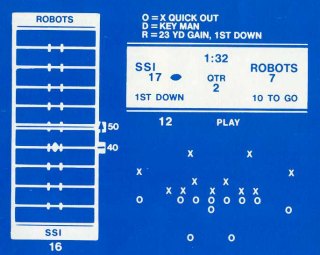
KICK-OFF
The kicking team has 30 seconds to decide whether to do a standard kick or try an onside kick.
This is selected by setting that team's game paddle or joystick (C-64 only) to one extreme
or the other. Once the selection is made, the player kicking may press the paddle or joystick
(C-64 only) button to proceed or can wait till time runs out and the kick will take place
automatically according to the last setting of the paddle. The ball will move on the screen
to the distance of the kick. If the ball goes into the end zone, the receiver has 4 seconds to
decide to run it out or take the touchback. This reply is given similar to the kick-off, through
the game paddle by turning the knob and pressing the button when a response is chosen. If time
runs out, whatever answer was last displayed is automatically selected. Other than these two cases,
you and your opponent simply watch the kick-off and the return from the sideline.
PLAY SELECTION
Plays are selecated through the game paddle or joystick (C-64 only). The paddle or joystick (C-64 only)
is set to the desired play number and the button is pressed to "set" the play. The
paddle or joystick (C-64 only) may then be moved and, unless the button is again pushed, the
play remains as set. The defense may "set" in this way anytime the play clock is running but the offense
must wait till the clock is below 26 seconds left (since they must huddle after the play).
When the offense first sets its play it immediately comes out of the huddle into its
alignment and a "hut" is sounded. (The defense never makes any sound when it sets). From the
time the offense is et, each player is looking at the formation of his opponent. Before then,
the defense is simply "showing" a standard 4-3.
To start the play going the offense must set the same play three times in a row. This is
equivalent to the quarterback calling for the ball on the third "hut". If the offense wants
to change its play, simply move the paddle or joystick to the desired play and start the
three counts again. Each time the quarterback changes the play at the line (by changing the
"set" play), there is a higher chance that someone won't get the signals and a "busted play"
will result. When the ball is hiked (after the third set of any offensive play) the results will
be displayed as they happen and the player can watch the outcomes of their scheming.
After a little experience with this play format, you should be able to handle your own input
and selection easily and then you con concentrate on trying to "read" your opponent. You can
watch for any subtle moves that amy give away what was (or will be) selected. Such "cheating"
is not discouraged since tactics like faking and "psyching out" are intergral to the real game
of football.
TIME OUTS
A time out may be called at almost any time during the game by simply pressing your
"time out key". For the left player that key is the letter "Z" and for the right it
is the "/" symbol. If a time out is called during the running of a play, it will not
be acknowledged till the ball is downed. During a time out the clock is stopped and
1 1/2 minutes are allowed for a rest.
However, the player who called the time out may press his paddle button to shorten that
wait and call time in. The number of time outs left to each player is displayed momentarily
between plays in the space usually reserved for entering play numbers. If a player calls time
out when he has none remaining, the computer will "beep" to indicate that fact.
An official's time out may be called at any time by pressing the space bar. The game will
temporarily suspended but nothing will be changed. When the space bar is again pressed,
the game will resume exactly where it left off. An agreement between the players as to when
an official time out may be called should be decided before the game starts.
HALFTIME STATISTICS
After each half, statistics will be displayed summarizing the play of each team. These are
emant for your entertainment and not as an absolute commentary on either team's performance.
Only the final score is really important.
NOTE: The statistics shown at the end of the game reflect the performace of the entire
game, not just the second half's.
OVERTIME
If both teams are tied after four quarters, one more "sudden death" quarter will be played.
Each team will be given 2 time outs and the receiving time will be determined by a new coin
toss. Whichever team scores first will be declated the winner.
PENALTIES, FUMBLES and INTERCEPTIONS
When a penalty occurs in the game, the team whom it's "for" (as opposed to against) makes
the choice of accepting or declining it through his game paddle. Simply adjust the reply
between "yes" (takes the penalty) and "no" (decline it), and press the button when satisfied.
All penalties in the game are marked off from the original line of scrimmage.
It can be disheartening to see your perfect play called back because of a penalty or,
worse still, to lose the ball when you know that it's just some damned random number generator
in the computer that did it to you! But even this element is parallel to the real game because
no team ever plans to fumble (or cause a penalty), it just happends. (Interceptions are a
little more predictable because some passes are simply more vulnerable to certain coverages).
The probability of such things happening varies from play to play but it is generally such a
small proportion that it sill feels unfair when it does come up.
MISCELLANEOUS ITEMS
Out of bounds: Runs to the sides have a 1-in-5 chance of going out of bounds; passes to the
sides have a 30% chance; and true sideline passes end up out of bounds 85% of the times they
are complete.
Minutes per quarter: The Semi-Pro version lets you specify the number of minutes per quarter
you would like to play. This is very useful to allow a new player to try a quick introductory
game before playing for real. However, ten minutes is recommended for any serious game to
insure that the teams get a chance to try all their tricks and level out their play.
Pass Completions: The probability of completion of a given pass is reduced anytime one is
attempted inside a yardage less then the average years gained with that pass. For instance a 30-yard
pass will have a lower probability of completion the closer you are to your opponent's goal inside
his 30. In addition, any pass inside the 20 yardline is 10% less likely and inside the 10 the
reduction is 25%.
Defense out of position: when caught out of position, the defense attempts to adjust to a 4-3
key man alignment with reduced capabilities.
COMPUTER VERSIONTHE ROBOTS
If you are dying to play a game but don't have a ready opponent, your computer will be glad
to oblige through this version. The game here is identical to the Semi-Pro one. The only difference
is that if you lose nobody else needs to know!
When playing against the Robots (the computer team), you can shorten its timeouts by pressing
its paddle button.
NOTE: The Robots have been programmed to play best with quarters at least 10 minutes.
UNIQUE TEAMS
You may play any of the versions of Computer Quarterback with teams that have unique characteristics.
These teams may be created by you or you may use actual historical BFL team available on "team disks"
from Strategic Simulations. At the start of any version of the game, you are asked if you would
like to play with unique teams. If you answer "Y" then you will be asked if anyone needs to
draft a new team (or revise an existing one). If you answer "Y" here, you will need to consult
the "Drafting Teams" section of this manual. Once both players have teams on disk, you can
continue by simply entering the name of the team you want to use.
The team will then be loaded from disk and you will be given a chance to assign unique play
numbers for use in the current game. You can make up your own numbers or let the computer pick them
for you sequentially or randomly. This feature is provided to reduce your opponent's ability
to "read" your signals. (In the computer version this option is unneccessary since the computer
can't tell one number from another - or can it?).
Apple owners: You may get a "hard-copy" of the play assignments and the team qualities if
you have a printer that works with a "PR#", (C-64 owners will see instruction on the screen.)
Otherwise you will be given a chance to view and record that information by hand before the
game continues. This entire process of drafting and preparing your speical team for a game should
be done in privacy. The only way a participant should be able to discover the quality of the
opposition's players is on the gridirion (or from "game films" if they are available). Until
the game (or the season) is underway, your best weapon is the fact that your opponent does
not know who your good and bad players are.
DRAFTING TEAMS
The first step in drafting your own unique team is creating a unique name - at least unique
to a particular data disk. (If you enter a name that is already on the disk you will be allowed
to revise that team). The name selected should be nine (9) letter or less and end with an 's'
for grammatical agreement.
In addition you may add a suffix that can serve as a special name or "secret password". If
you wish to use a suffix, type a slash "/" followed by any letters or numbers (symbols are not
allowed). The game and suffix (including the "/") will have to be entered exactly to load the
team for use in a game but only the name itself will be displayed in the catalog and during the
game.
Thus, a name such as "STEELERS" with a suffix "/BRADSHAW" will require you to type
"STEELERS/BRADSHAW" to load the team while only the "STEELERS" part will be used during the
game and the catalog will show "STEELERS/". Numbers are the only exception to this since numbers
in the suffix will be displayed in the catalog but not necessarily during the game.
For instance if you are playing the teams "STEELERS/80" and "COWBOYS/80" the catalog will
display the full titles but during the game only the names "STEELERS" and "COWBOYS" will be
used. This approach allows you to create team with secret codes or to use Stratecig Simulations
"Team Disks" without unnecessary numbers in the team names.
The next step is the allocaction of money to buy teams. The players should have arrived
at a mutual decision concerning how much (if any) handicap one player has in relation to another
before starting this phase. A total beginner when facing an experienced player may be given the
maximum funds to equalize the game.
However, it is essential for realism during the game that player stay close to the average
funds available. Two players who have both asked for double the average funds will not have
nearly as realistics a game as if they had requested the average amounts.
After you have received your money, a screen will be displayed that shows the categories in which
you may invest. The offensive backfield, the receivers and the kicker are identifield individually
and the remainder of the squad is made up of the offensive line, the linebackers, the deep
backs and the special teams.
For each of these individuals and groups a minimum cost, an average cost and a maximum cost
is given. For a minimum investment in any category, you will get performance at 70% average.
The maximum investment will buy 130% performers or 30% greater than average. (These values
are based on years of human engineering analysis which has found that in any field of
endeavor, 99% of the "accpetable achievers" range within plus or minus 30% of the norm.)
The next column displays in inverse video the current investment which will be initially
set to the average in each catagory. The last column shows the quality of player the current
investment will buy.
You may change a value by typing in the desired number followed by a "RETURN", or you may
leave it as is by simply pressing "RETURN" without any numbers (or use + to just go to the
next item). You may also go back to a previous category by pressing the minus key ("-") at
any time.
In this way, you nay go forward and backward, changing your investments until the money
available equals the money spent (AMT, LEFT=0) and you have the team you want. Any time you
specify the kicker category, the question "FINISHED?" will appear at the bottom of the screen.
If you answer "N" or do not have enough money to buy the qualities you asked for, you will get
to start again at the top of the list.
Your team will then be written to disk where it can be used as often as desired. A team can
also be "revised" simply by using the same team name when drafting a team later.
IMPACT OF THE DRAFT
The player's qualities affect the outcomes by affecting the values of the model for plays in which they are
involved. In all cases, the higher the quality of your players versus your opponent's, the
more favorable is the adjustment towards you. The following is a summary of the relationships
of player quality to various elements of the game's model.
"Break-away run" is the probability the runner will break into a deep gain. This is influenced
heavily by the runner's quality and supported by the quality of his line. It is opposed heavily
by the linebackers and they are supported by their line.
Fumbles are adjusted up by the rating of the overall defense and are reduced by the
quality of the ball carrier.
The average gain on a rushing play is improved by the runner and his line and is opposed
by the linebackers and their line. Runs in excess of the average are further adjusted by the
runner versus the linebackers and shorter runs are revised by the conflict of the offensive
line versus the defensive line. For instance, if the offense is rated at 130% in its runner and
line and the defensive quality in the line and backers is 70%, then the average yards gainted
for a given running play will be increased by 60%, fumbles will be reduced by 60% and all other
outcomes will be increased by 60%.
Pass interceptions will be increased direclty with increases in the quality of the deep
backs (safeties and cornerbacks) and the linebackers but will be decreased by the qualities
of the quarterback and the receiver.
Trapping of the quarterback behind the line on passing plays will be reduced to a lrage extent
by the offensive line quality and to a small extent by the quarterback himself. It will be
increased by improvements in the defensive line's ratings.
Pass completion percentages are improved equally by the quarterback and the receiver and
are reduced considerably by the defensive backs (linebackers and deep backs) with aid from the
defensive line.
The average yards gained on a pass are a result of the receiver's quality versus the defensive
backs. Long gains are found through the conflict of the receiver and the deep backs, short gains
between the receiver and the linebackers.
All kicks are directly related only to the quality of the kicker (He represents both the
punter and the place kicker). Runbacks and blocked kicks are determined by the opposition of the
two special teams categories.
PROFESSIONAL VERSION
The Professional Version of this game offer the following features in addition to those of
the Semi-Pro: three defensive alignment "sets" ("tight" tro strengthen the middle, "spread"
to cover the flanks, and "standard"); double-teaming of the split end, tight end, or flanker,
18 more offenses, 10 more defenses (making 36 offenses and 24 defenses) and creation of game films.
DEFENSIVE ALIGNMENT AND DOUBLE TEAMING
Both of these "settings" are entered as normal plays using the number you assigned them
and remain in effect till they are given new settings. At the start of each possession the
defensive line is set in a standard alignment and the defensive backs are not double teaming
anyone.
The "plays" to revise both of these settings may be entered any time before or after calling
a "real" defensive play. A note informing both players that the defense has changed either alignment
or double teaming will be displayed with the results of any play in which that change was
important. If, for instance, the defense changed from a standard alignment to a tight one, that
change will not be mentioned until the offense calls a run and the defense is in a keying line set.
The alignment only affects running plays on which the defense is not blasting, stunting,
dogging or blitzing. Runs up the middle will be reduced by 10% for tight alignments and increased
by 10% for spread ones. The opposite effects are imposed on a run outside.
Double teaming affects only passed where the defense is in standard man-for-man coverage
and is not rushing any backs (dogging, blitzing or 6-1). A double teamed receiver will have the
completion rate of passes thrown to him reduced by 30% plus a small increase in the chance of
interception. However, while he is being double covered, all other receivers have a
10% greater chance of catching their passes.
GAME FILMS
The Professional version allows you to create a permanent record of all the action that takes
place during a game in the form of "game films". You need a printer that prints at least 80
columns per line (and for the Apple only, is turned on by a "PR#"). If you meet these criteria,
after each play, the computer will print a line that consists of (from left to right): down
situation before the play was run, yards to a first down before the play, absolute yard mark
(the distance the offense was from a touchodwn before the play), the game clock setting when the
30 second clock started, the play called by the "left" team, the play called by the "right" team,
the result of the play. A number of asterisks will mark the offensve team's column whenever a
change in possession occurs. Headings for quarter and score changes will also be given.
The permanent log provided by these "game films" should allows opponents a chance to review
their strategies, uncover tendencies and prepare for upcoming games.
CLOCK CONTROL
Because you can play this game with virtually no physical exertion, players usually call
plays in the first few seconds after the 30 second clock starts. In a real game this is seldom
the case. With receivers straggling back from deep pass routes, players shuffling in and out
from the sideline and everyone catching their breath, quarterbacks in the NFL use most of the
30 seconds allowed between plays.
Thus, in a regulation (15 minute quarter) game, Computer
Quarterback players would run more than twice the number of plays as a normal NFL game. To
compensate for this, a provision is made to subtract a certain amount - called the inter-play
delay - from the clock after each play regardless of the outcome. (In the last 2 minutes of
each half only a fourth of this amount is subtracted after each play). In the Professional
version you can specify the inter-play delay to be any amount; however, a figure of at least
10 (for 10 seconds per play) is recommended.
PLAYOFF GAMES
In regular season games, a single overtime period is provided to break ties after regulation
time. If the game is still tied after that then each team is given a half a point in the
standings. However in playoff games, overtime periods are repeated indefinitely until
someone scores. The Professional version facilities this by offering you a chance to
continue after each overtime period.
LEAGUE PLAY
After over a year on the market, Computer Quarterback has spawned leagues for playing this
game all over the country. The following are some hints for conducting a successful league.
You need at least 6 people to have a league. If you have around ten, you can form two
conferences, and if you have 16 or more you can split the conferences into divisions.
You should have at least half as many computers and copies of Computer Quarterback as you have
players, otherwise scheduling can become a nightmare and an imposition on the few Apple owners.
Appoint, elect or draft a commissioner to take care of preparing the schedules, maintaining the
"game films" library, certifying the draft for each team, keeping the league treasury and
generally coordinating the season. The commissioner should almost never be allowed to participate
with a league team unless he/she us such a horrible player that knowing everything about
everyone else's teams will still not help him/her win. (This job can almost be fun for a real
organizer type).
Draw up a reasonably firm schedule and make any failure to meet it a forfeit. Don't schedule more
than two games a week for any team and try to stick to regular days of the week. Make sure each team
plays everyone in their division at least twice and all the rest at least once before you
start playoffs. But don't make the season last too long or the losers will quit showing up.
Start the season with your teams drafted using only 75% of the average funds. Each week
allocate another 5% of the funds to revise key players to higher quality ratings. Don't allow
reductions in player qualities during the season (unless you are trying to include injuries in
your league). In this way you can model the improvements that take place during the season as
coaches work on particular positions and personnel.
Maintain a file of "game films" on all league games and loan copies of two recent games to
each player concerning their next opponent.
Charge a reasonable entry fee (like $5) to join the league and use the proceeds to pay for
copying, to get a small trophy for the "Super Bowl" winner and to provide beer for all the
spectators.
Contact Strategic Simulations if you form a league and come up with your own successful
methods. Also let us hear from you about potential enhancements to Computer Quarterback for
later updates. We are interested in anything that will help make our products more enjoyable
to you.
THE OFFENSE
Almost all pro football plays are run from what is called the "three end offense". This
alignment is a development of the modern passing game, since it places three receivers at (or
near) the line. These are: the split end, the tight end, and the flanker. This formation creates
an unbalanced line that can also be very effective fur running plays. The side with the tight
end is called the "strong" side and the other the "weak". The line positions as shown below
are (from left to right): split end, tackle, guard, center, guard, tackle, and tight end.
The backfield is made up of the quarterback, flanker, halfback, and fullback.
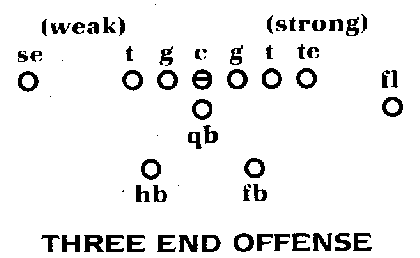
There are three main backfield shifts used to provide a variety of attacks from this offense.
They are: spliy backs, weack back and the "I". All are shown below.
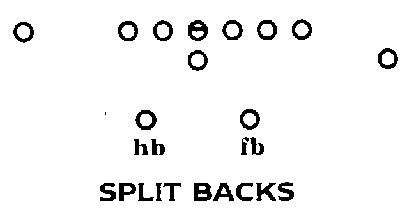
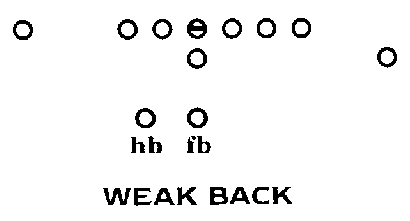
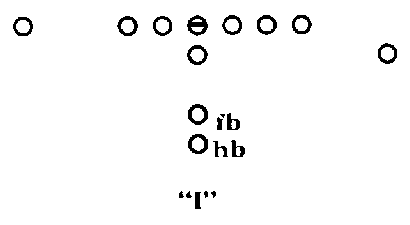
Although some professional teams occasionally flip the split end to make the opposite side "strong",
for simplicity in this game the strong side will aways be on the right.
THE OFFENSIVE PLAYS
* indicates Semi-Pro plays
RUNS
Cross Buck This quick run up the middle by the halfback is set up by a cross block of
the left guard and center. It is good for a couple of yards. This play has the lowest chance of
fumble of all your plays and like the dive is often the only thing that works against
short yardage.
*Dive The dive is an up and over by the fullback. The line tries to wedge the
defense back from the center. Short yardage is all this play is genereally good for.
*Middle Blast The fullback blasts a hole in the center of the defense and the halfback
follows him through. You can almost always count on a few yards, and against a blasting or
stunting defense this play can break for good yards. This is a real "bread and butter" play for
sustaining a good ground game.
Tackle Blast On this bladt play the halfback leads through the hole between the left
tackle and guard and is followed by the fullback. Gains here are slightly lower then the middle
blast but it will get their attention if they are over shifting. A good conservative run play.
Power This play is like a quick sweep with only the weakside guard pulling and the
halfback cutting on the inside of the tight end instead of going all the way around. This play
should avearage around 5 yards but can also be caught in the backfield by blitzing backers. This is the
beginning of the standard runs that can gain 5-10 yards but get riskier.
*Slant This simple off-tackle run is the most popular play in the NFL. The fullback slants
to the weakside and, depending on the blocks that are made, may run straight ahead or cut inside
or outside. This mid yard-gainer is popular for good reason.
*Trap The strongside defensive end is the target for this solid rin. The halfback
has good breakaway potential with this play - especially if the defense is blasting.
*Sweep This play is powerful! It is almost the only choice if you need more than
5
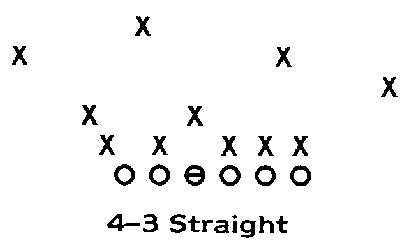
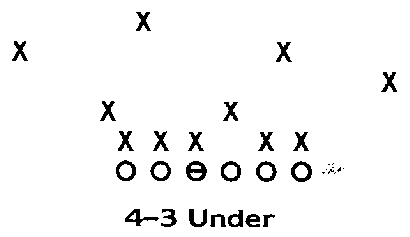
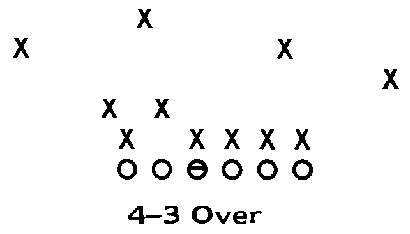
There is one other variation to the 4-3 alignment called the 6-1 here. In this formation both
outside linebackers move up to the line. This is used for blitzing or when a run is expected.
If the play looks like a pass the line backers can drop back into a man-for-man coverage.
Another defensive alignment that is becoming more common in the NFL is the 3-4. The success
of the Miami Dolphins and the Houston Oliers using this defense extensively has encouraged its
addition into the arsenal of many other teams. A wide variety of shifts are used with the 3-4 to
reduce its weakness to the run and to beef up the three-man pass rush by moving one of the
linebackers to the line.
These shifts are parallel to the 4-3 with over or under adjustments and thus are not part of
this game. Only the 3-4 short xone play is included because of its unique advantages. There
are other special-purpose formations that will be explained under the plays that use them.
THE DEFENSIVE PLAYS
Defensive plays are essentially just combinations of assignments for the line and deep backs.
Thus, except for special alignments and special purpose plays, defenses can be easily described
by a few key words that define those assignments.
LINE ASSIGNMENTS
Keying When the line is assigned to "key", it watches the offensive team and attempts
to "read" the play. This is usually very effective against runs. It gives the defensive linemen
some time to respond to the changes of the offense. This defensive line assignment won't really
hurt the offense often, but also won't usually be hurt.
However, the offense developed two types of plays that take advantage of a keying defense;
they are the misdirection run and the play action pass. The probability of success of either
of these offenses will increase as a defense repeatedly keys. (The tight, spread, and standard
defensive alignments may be used in the Pro version with this type line).
Blasting A blasting line does not key on anyone. The linemen rush straight into the
offensive backfield and attempt to collar whoever has the ball. This makes the blast a
much better pass rush than a keying line.
Slow developing runs and play action passes are also very vulnerable to the blast. However,
rushing linemen are easily trapped or nudged out of the way for a fast play up the middle. Thus,
a blasting lineman may break up a play in the backfield or the defense may let a modest gain
become a big one.
Stunting This is a twisting blast where the linemen on each flank go around either side
of the respective offensive tackles. Plays using this defensive line assignment can dump the
passer even better than a blast. The offensive blocking of certain runs (such as the trap and
draw) is also disrupted, often catching the runner in the backfield. But the stunt, like the
blast, is generally riskier than the key.
BACK ASSIGNMENTS
Man-for-Man In plays using this type of backfield, each defensive back is assigned to
cover one receiver. Different defenders will cover the offensive backs, depending on where the
backs go. If no backs go out, the linebackers help out against other receivers.
This assignments is slightly better against the run than zones because the linebackers are
watching the offense rather than rushing to get to their zones. For pass coverage, man-for-man is
better against passes aimed at splitting zones. Overall, "man" coverage is often better than
the wrong type of zone. (In the Pro version, this coverage also allows double teaming of
specific receivers).
ZONES
In general, zones provide better pass coverage than man-for-man. They were introduced to
vombat the increased sophistication of the passing game. Better receivers, ore diverse pass
patterns and the increasing accuracy of passers have made zones a necessity in pass coverage.
With a 4-3 defensive alignment, there is a variety of methods to arrive at the four short
and three deep zones. For the purposes of this game, only two rotations are used - strong
and weak. The patchs used by the defenders to arrive at these two alternatives determined where
the "seams" are and which passes will be more or less effective against them. Against runs,
zones are just slightly less effective tham man-for-man.
Strong Zone In this type of zone, the deep safeties rotate to the strong side
(thus giving it its name) and the remainder of the backs move to their assigned positions.
This rotation all but shuts down passes to the flanker (Z). Strong zone is especially vulnerable to
passes to the weak side.
Weak Zone This rotation is similar to the strong zone but on the opposite side. Thus,
passes to the weak side are less likely to be complated, and those to the strong side are more
suce successful.
3-4 Zone The particular zone used with the 3-4 alignment in this game has 6 short
and 2 deep zones. All types of short passes become almost impossible with this type of defense.
Passes of medium length are covered at least as well as man-for-man coverage. However, deep
passes are not covered very well. Running plays take advantage of the weak 3-man front and
the dropping linebackers to add a few yards to the runner's gain; but a breakaway run against
a 3-4 is less likely than against a 4-3.
Man-for-Man Short, Deep Zone This defense type provides man-for-man coverage with
the addition of two deep zones made by the deep safeties. This combined coverage makes long
passes very unlikely, nut is slightly less effective than a standard "man" for short and
medium passes. (Double teaming is not available with this play because the safeties have
fixed assignments).
Dogging In plays with this backfield assignment, one or two of the linebackers rush
into the offensive backfield along with the linemen. (The blast assignment for the line is
assurned with all dog plays). The designation "strong" means the left (strongside) linebacker
will blast.
"Weak" stands for the right backer, "mad" for middle and "red" for the outside linebackers.
As with the blast and stunt line assignements, backs who are rushing may miss the play completely or
might throw it for a big loss.
SPECIAL ALIGNMENTS
4-3 Over Three of the four linemen "over" shift to the strong side and the middle
linebacker moves slightly to the weak side. This shift is very powerful against runs to the
strong flank and very vulnerable against plays to the opposite side. Both over and under
shifts place a lineman directly on the nose of the center, and in that way, confuse
the blocks of offensive linemen used to the standard 4-3. Thus, runs up the middle are less
likely to succeed.
4-3 Under This shift to the weak side works just the opposite of the over 4-3.
Plays to the weak side are halted and runs up the middle slowed. Passes are unaffected by
either the over or under shift.
6-1 Key Man In this play, the outside linebackers in the 4-3 move to the line to
stop a run. Although they drop back if it looks like a pass, the backs have already lost
a step or two on a fast receiver. This makes the 6-1 less effective than the standard man-for-man
against most passes and it really gets fooled by play action passes.
SPECIAL PURPOSE PLAYS
Safety Blitz Here the defense goes all out to dump the play in the backfield. All the
linebackers and the strong safety blast in with the linemen to stop the offense for a big loss.
But, if it doesn't work, the offense may have a big gain.
Short Yardage This play can really kill a drive that faces a third down and one or
two. It is also useful for second and one; foruth and one, two or three; and anytime within your own 5-yard
line. If you use it in any other longer yardage situation, you run the risk of a runner breaking
for a big gain or of letting a receiver catch the ball just behind your tight line.
PreventThe entire backfield drops to cover medium and long passes with this defense.
Prevent should be used when they need a big gain in a hurry. They can have the short plays
and runs, but it is unlikely they'll get much more than 15 years.
Punt Return This play is ued to return a punt or to rush any kick (field goal or punt).
On a standard punt, you will be asked if you want a fair catch. You will have four (4) seconds
to reply. It's a good idea to take a fair catch on a short kick to avoid the risk of a fumble.
If the offense decides to get tricky and not kick the ball, you are in a type of short
yardage alignment so they won't get too far.
DEFENSIVE STRATEGY
In playing good defense, just like in playing the offense, you need to know your team, your plays
and your opponent's tendencies. You also need to know when to "contain" or even push back the
offense and when to bend so you don't break. If the offense isn't too strong, you might get
away with playing conservatively by keying and not giving away any big gains. But if they
are really rolling over you, then it may be time to go on the "offensive" - using blitzes, blasts,
stunts, overs, unders - or anything that will stop what you anticipate thay will try. Then,
when have third and long, you can sit back and just take away the long plays.
DESIGNER'S NOTES
The development of "the world's best football game" has been a labor of love spanning several
years. In 1976 I developed a much "looser" program on a Varian mini-computer and uncovered
some of the difficulties in simulating a football game. Using that computer and all the other
facilities of my employer, I analyzed hundreds of plays and thousands of outcomes. At that time
I discovered the key statistical relationships that were eventually used in this simulation
model. For almost a year I have spent the major portion of my "free" time attempting to implement
all those good ideas into a playable game. The first major obstacle was creating some method of
including unique team abilities. In playing earlier versions of the game, it was apparent that
without such a "personal" touch, players would eventually tire of playing their mirror image.
Every trick I developed against a given opponent could be turned against me unless our teams
had their own special traits. Thus, the draft was included and the model revised to allow modification
to outcomes based on key players.
However, my greatest and most urgent challenge came when SSI asked that I create a "solo"
version that could be played against the computer. With only two weeks available, I had to find
some way to create an intelligent programmed opponent. My experience with simulating cybernetic
systems was helpful but the demand fur urgency and quality almost inundated me.
After a couple of "bright ideas" failed, I tried a standard optimization technique called
weighted scoring. This seemed to work and I finished the program just in time for production.
I will leave it to you to decide if I created an "intelligent" player.
Obviously I couldn't have done this alone, so I have to mention some of the support I
received: Glen Ross, a retired football player and engineer, who helped add realism throughout;
Wally Hall, a local sports-writer, who provided encouragement and data; the Apple Addicts
computer club who helped in testing; and finally my wife and daughter for their patience and support.
TECHNICAL MODES NOTES
This game is based on an original stochastic simulation model. Various fixed probability
distributions and discrete values are used to generate outcomes in the game. The combination
of all these processes creates very realistic results.
There are really three separate models used - one for each of the major types of offensive
plays: runs, passes and kicks. For each running play against each defense there are five
values used to generate outcomes. These are: the probability of a fumble, the probability of
a breakaway run, the average yards gained (excluding breakways), the standard deviation on
the pluse side and the standard deviation on the minus side.
The last three items allow the creation of outcomes from a skewed distribution using a simple
normalized random variable. Each of these five parameters is also adjusted in the Pro version
by the quality of the players in particular positions. For instance, the minus standard
deviation is influenced by the offensive and defensive lines while the plus standard deviation
is the result of the conflict of the runner versus the defensive backs.
For passing plays, seven variables are used to determine the success of an offense against
a defense. Four of these are used for each such combination of plays; they are: the probability
of interception, the probability of pass completion, the probability that the quarterback is trapped,
and the average yards gained when complete.
Also associated with each pass play - one for each offense - are: probability of fumble, the
standard deviation on the plus side and the standard deviation on the minus side. As with
runs, each of these parameters is individually affected by the qualirt of the teams' players
in key positions when the Pro version is being used.
Overall, this methodology allows a great deal of flexibility in the development of play
outcomes. Non-continuous conditions can be easily modeled by adjusting certain parameters with
other conditions. For instance the short yardage defense is very effective with only a few yards
to a first, but is otherwise fairly risky. To maintain realism in this case, the probability
of breakaway is increased according to the distance to first down for any yardage greater than
the down number.
The third model, the one used for kicks, is really just a type of model, Each of the kicks
and returns has its own polynomial regression formulas that create continuous yardages mimicking the
real-life distributions.
In all, almost four thousand variables were calculated and stored in memory for use in the
model. These are stored as single bytes since using standard floating point variables would have
required as much as 20K of program space. Using these values in the model to generate outcomes
means that even repeated combinations of the same plays will provide unique results.
All yardages created are continuous integers that can theoretically range from positive infinity
to negative infinity. However, since these yardages are normally distrbuted, they will tend
toward their respective averages.
|